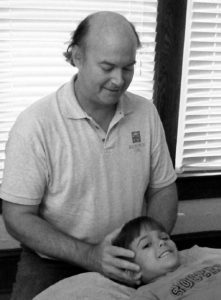Craniosacral Balancing
Restoring the Natural Rhythm
Call for an appointment at 904-826-1965
Our Wondrous Body and the Craniosacral System

We live in a marvelous mechanism for expression-our body. Our every move depends on the health of our soft tissues: fascia, ligaments, tendons and especially our muscles. Movement is inherent in our wondrous body. When we breathe, our body responds in expanding and contracting cycles. Our blood and lymph rhythmically pump and bathes all our tissue in life-giving fluids. A less-emphasized system that is essential to our life is the craniosacral system.
The craniosacral system consists of the brain, the spinal cord, the connective tissue sheath which surrounds them, the cerebrospinal fluid, the skull, and the spine. The cerebrospinal fluid bathes and cushions the spinal cord and brain from cranium (skull) to sacrum (base of the spine). The cerebrospinal fluid rhythmically circulates just as blood and lymph circulate throughout our body. Because of trauma such as birth and accidents, the cerebrospinal fluid does not flow in a smooth and rhythmical manner. Concurrent with this dysfunction, other body parts do not move in a symmetrical manner. These problems have a profound influence on our health.
Craniosacral Balancing
In the hands-on therapy field, massage and other techniques are used to enhance the circulation of blood and lymph. A relatively new technique, Craniosacral Balancing is performed to unblock any restrictions in the flow of cerebrospinal fluid. Craniosacral Balancing also addresses other biomechanical imbalances related to the spine and extremities. This craniosacral technique restores the natural mobility of the tissues in their rhythm with cerebrospinal fluid, blood, and lymph.
The Balancing Touch
Craniosacral Balancing is a gentle, non-invasive yet powerful therapy. By lightly manipulating the skull bones at the sutures (joints), craniosacral therapists realign the bones so that they move in symmetry with one another, allowing the cerebrospinal fluid to circulate freely. This process releases soft tissue adhesions around the spine, which has far-reaching effects via the connective tissue throughout thebody
Craniosacral and Chronic Pain
The body adapts to trauma by compensating for its inability to function normally. The body goes on “red alert” with the glands and nervous system operating at full throttle. After the emergency, the nervous system and glands do not always shut down. This abnormality causes high bloodpressure, contracted tight muscles, and general fatigue of the system resulting in pain.
Craniosacral Balancing has been effective in relieving headaches, neck pain, tinnitus (ringing in the ears), back pain, trigeminal neuralgia, facial pain, TMJ-D (jaw pain), meningeal inflammation, and migraines. This therapy has also been effective in treating strokes and brain and spinal cord injuries.
Craniosacral and Emotional Release
Emotions imprint holding patterns known as “body armor” in the fascia and musculature. The body literally becomes “knotted up.” This physical element of emotional blockage has been treated effectively with Craniosacral Balancing. Anxiety, neuroses, depression, and the scars of sexual abuse have all been lessened or relieved.
Craniosacral and Kids
Craniosacral Balancing has a long history of special application with children and infants. A great deal of stress placed on the skull and spine of the baby during birth. Craniosacral Balancing holds a unique place among therapies in treating the trauma of birth. Techniques have been developed to treat hearing problems, ear infections, hyperactivity, bedwetting, attention deficit disorders, dyslexia, learning disabilities, cerebral palsy, fever, and scoliosis.
The Craniosacral Therapist
Craniosacral Balancing is safe and has no side effects. The few contraindications include acute intracranial hemorrhage, intracranial aneurysm, recent skull fracture, herniation of the medulla oblongata and recent stroke. Craniosacral work is done on people who are fully clothed. Craniosacral Balancing has its origins in Cranial Osteopathy.
Craniosacral Balancing is practiced by healthcare professionals who include osteopaths, chiropractors, physical therapists, and massage therapists. An in-depth certification program incorporating concentrated study is required to attain the high level of competency needed to perform this therapy.
Craniosacral — An In-Depth Look
If you would like to know more about Craniosacral Balancing, read Craniosacral Therapy: Touchstone for Natural Health by John Upledger, D.O.
Call for an appointment at 904-826-1965
Professionals who what to learn more about Craniosacral Balancing. — We recommend these books:
 | An Introduction to Craniosacral Therapy: Anatomy, Function, and Treatment by Don Cohen and John E. Upledger An excellent introductory guide for therapists. Surrounded in ancient hands-on methods of diagnosis and treatment while encompassing the innovations of the early experimental osteopaths, craniosacrally-based treatment is now one of the most successful and fastest-growing approached to mind-body healing. |
|---|---|
 | Craniosacral Therapy and the Energetic Body: An Overview of Craniosacral Biodynamics by Roger Gilchres Gilchrist demonstrates how the subtle patterns of this practice become a dynamic force in the body, and how this influences overall functioning. What most sets the book apart is Gilchrist’s discussion of the relationship of the craniosacral system and biodynamic functions to the human energy system. |
